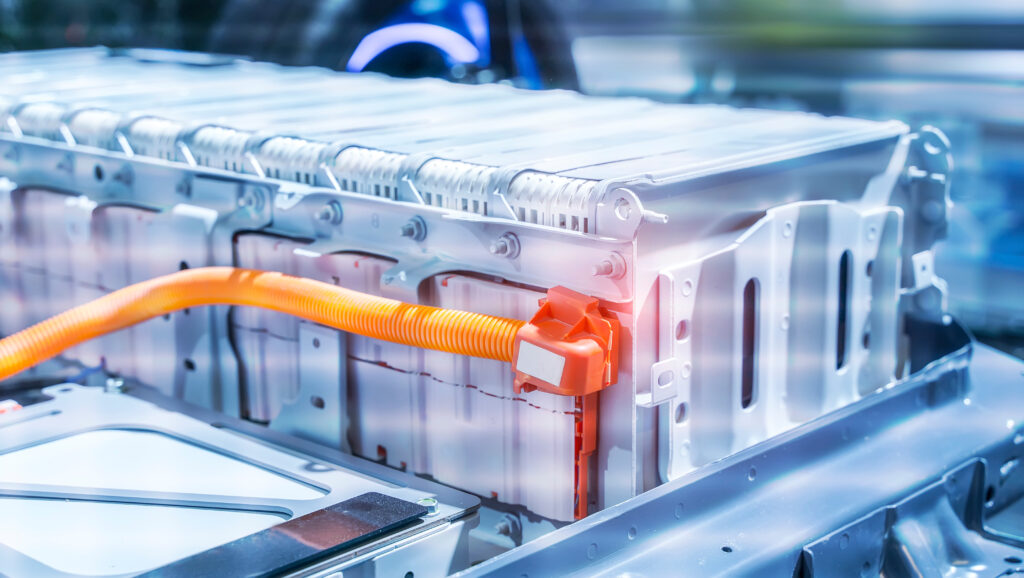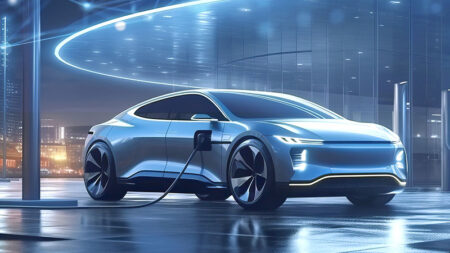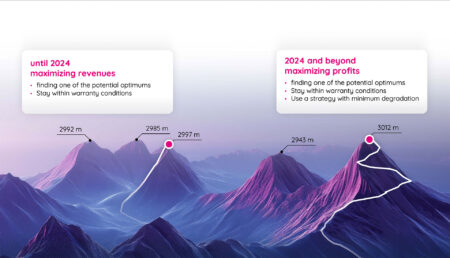
The Battery is a Complex Creature – Battery Analytics and Monitoring Illuminate its Complexity
volytica specializes in energy diagnostics and monitoring of batteries. What exactly do you do?
With our battery monitoring solution, we scan the health of batteries, essentially creating a continuous ECG of the battery. We do this by evaluating existing and available data. Every battery system has the same structure. Cells are connected in series or parallel to achieve a certain energy density and voltage level. A number of sensor types are installed as standard: voltage sensors, temperature sensors and current sensors. These measure how much current is flowing in and out. The interaction of these sensors provides important information that allows us to infer the inner workings (condition) of the battery.
What types of batteries do you monitor?
 We monitor all types of batteries, especially those used in electric vehicles, home storage systems, and large stationary storage systems. We monitor large e-bus fleets in Europe, as well as large fleets in Texas and Italy with hundreds of containers for the Italian utility Enel. Enel collects data from the power plants, including the battery storage systems. From this data, the user receives information about the capacity, state of charge, aging, and possible deviations or anomalies of the cells in their control system (SCADA) or on the Volytica dashboard. The new vdx sentry function not only highlights the most important alarm messages, but also provides specific recommendations for action. This saves the customer time and money.
We monitor all types of batteries, especially those used in electric vehicles, home storage systems, and large stationary storage systems. We monitor large e-bus fleets in Europe, as well as large fleets in Texas and Italy with hundreds of containers for the Italian utility Enel. Enel collects data from the power plants, including the battery storage systems. From this data, the user receives information about the capacity, state of charge, aging, and possible deviations or anomalies of the cells in their control system (SCADA) or on the Volytica dashboard. The new vdx sentry function not only highlights the most important alarm messages, but also provides specific recommendations for action. This saves the customer time and money.
The idea is to use used batteries from electric vehicles as stationary second-life storage units. However, these plans are often not implemented, probably because no adequate information about batteries is available. What are the reasons for this?
 Because there are not enough companies like us. The used storage systems are available, but there is a lack of confidence in their performance. The big problem with second-life batteries is that the buyer usually wants a guarantee on their performance. To be able to give this guarantee as a seller, you need to know the exact condition of the battery. This requires full transparency. In 2022, together with TÜV, we facilitated the largest resale of an e-bus fleet. We made this possible by providing a transparent assessment of the battery’s condition. While TÜV inspected the vehicle and roadworthiness aspects, we, as an independent software provider with many years of battery expertise, assessed the exact condition of the batteries, which accounted for 45% of the total value.
Because there are not enough companies like us. The used storage systems are available, but there is a lack of confidence in their performance. The big problem with second-life batteries is that the buyer usually wants a guarantee on their performance. To be able to give this guarantee as a seller, you need to know the exact condition of the battery. This requires full transparency. In 2022, together with TÜV, we facilitated the largest resale of an e-bus fleet. We made this possible by providing a transparent assessment of the battery’s condition. While TÜV inspected the vehicle and roadworthiness aspects, we, as an independent software provider with many years of battery expertise, assessed the exact condition of the batteries, which accounted for 45% of the total value.
Are there enough batteries for reuse or use in second-life applications on the market?
Yes, but there is a lack of transparency about their status. However, many market participants are not yet sufficiently aware that diagnostic companies like ours exist. There is, for example, the Cling platform, with which we are planning to cooperate in the future, through which used batteries can be purchased. So the supply does exist. The problem is that prices for second-life batteries are low because buyers always consider the risk of batteries with short life and low performance.
Does such a secondary use make economic sense?
According to our calculations – and there is also an EU study that confirms this – it always makes more economic sense to keep the battery in its first use for as long as possible. This is because replacing a battery with another application entails one-off costs that make the business case even more difficult.
Transferring a battery from an electric bus to a battery storage system, for example, costs several thousand euros due to the necessary adjustments to the connector (plug, settings). Every day we see batteries being replaced prematurely when they could still be used. Unfortunately, they are often replaced at the end of the warranty period and not at the end of their useable life. Continuous monitoring not only detects system failures, but also allows customers to maximize the life of their batteries.
Many tips are circulating about charging and discharging batteries. How much does correct charging benefit batteries?
Batteries are very sensitive to the conditions in which they are used. Battery life can easily be increased by 20-30% with the knowledge of proper commissioning. However, this varies from battery to battery and also requires extensive analysis.
For example, what is the best way to charge and discharge an electric vehicle?
 Three factors affect the rate at which a battery degrades. These are the temperature, the charge and discharge rates, and the state of charge range in which the battery is stored or operated.
Three factors affect the rate at which a battery degrades. These are the temperature, the charge and discharge rates, and the state of charge range in which the battery is stored or operated.
To protect the battery of an electric vehicle, it should be left out of the sun as much as possible to avoid overheating. This is because battery life is highly dependent on temperature. Batteries that are stored too hot have a shorter life than batteries that are stored in a cool place. Conversely, if they are stored too cool before being charged, they will be damaged. So the first recommendation is to park in the shade.
The second important aspect is the state of charge. Being full or empty is not good for lithium-ion batteries. A medium state of charge is best for long battery life. So the second recommendation is to keep them at a medium state of charge as long and as often as possible.
And third, and this will surprise many, it is better to recharge more often, ride small hills – i.e. ride, recharge, ride again, recharge, and so on – without completely discharging the battery. As a rule of thumb, this applies to all lithium-ion batteries. It is also important to avoid rapid charging.
How does grid-connected charging affect the batteries?
If implemented correctly, it can be battery friendly. We have just completed a study on this issue with the Italian grid operator. There are scenarios where the life of the battery benefits from grid-assisted charging. But there are also scenarios where the battery ages twice as fast, for example if it is not treated properly. A battery does not necessarily age faster when it is used. A battery ages even if it is not used. Sometimes it is better to use it than not to use it. The battery is a complex creature.

We would like to thank Stefanie Dierks for joining us at Intersolar EES in Munich 2024 and for her time and effort in conducting this interview. We are always eager to share our battery knowledge and appreciate the opportunity to discuss the latest advances and challenges in the field. Your support allows us to continue to expand the boundaries of innovation in battery technology.


